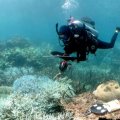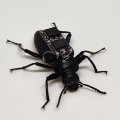The University of Queensland enrolled a record number of first-year students in 1996, including 80 percent of students who achieved Overall Positions of 1, according to the University's annual report tabled in State Parliament.
The report shows a record 10,198 students enrolling through the Queensland Tertiary Admissions Centre accepted places - an acceptance rate of 92.3 percent.
The University's share of students in the top three OP bands also rose from 64.2 percent in 1995 to 68.1 percent, a proportion of 50 percent more than its nearest Queensland competitor.
In total, 27.2 percent of all Queensland school leavers beginning tertiary study in the State in 1996 enrolled at the University, which admitted more school leavers than any other Queensland university. School leavers enrolled at the University had a median OP level of 7; the median for those entering tertiary education was OP 10.
Overall, student enrolments rose to 26,407. An extra 425 places were provided, with the increased enrolments a Commonwealth initiative to provide more tertiary places for Queensland, in response to pressure from State representatives.
Vice-Chancellor Professor John Hay said in his review that high demand for places, positive graduate outcomes, outstanding success in competitive research funding and widespread evidence of community service attested to a sound performance during the year.
To maintain the momentum, significant plans were laid for the future.
'We met the self-imposed challenge of devising a major academic and administrative restructure to operate from January 1, 1997,' Professor Hay said.
'Potential benefits will include streamlined decision-making and resource management, more flexibility and swifter response to opportunities for advancement in a period of rapid transition for the higher education sector.'
Professor Hay said the University Senate had taken a momentous step in deciding on the Challinor Centre in Ipswich as the site of a new campus following many years' deliberation on options for higher growth.
'An interactive-high technology facility is being planned where, for example, students will be able to study for dual degrees at more than one campus, thanks to alternative delivery and flexible scheduling,' Professor Hay said.
He said the winds of change were also manifest in a new learning-led policy on student assessment to apply from 1997, and a new intellectual property policy to protect the rights of students, staff, the University and contracting agencies.
'Both will encourage and reward good performance,' he said.
The report showed the University in 1996 employed 2611 teaching and research staff and 2673 general staff, and had a total operating revenue of $443 million ($462 million with consolidate entities) including $248 million in Commonwealth grants and $44 million in HECS.
The University was recognised as one of Australia's top four research universities in the research quantum - the Federal Government's annual allocation based on research performance.
Students were well-represented in national and international awards, including the Rhodes Scholarship for Queensland; and high-achieving graduates included Professor Peter Doherty, joint winner of the 1996 Nobel Prize for medicine.
The report noted that extremely high employment rates for first-degree graduates confirmed the value of University of Queensland degrees. A survey, taken by the Graduate Careers Council of Australia of December 1995 graduates, showed 87.1 percent of University of Queensland new graduates available for work had found full-time employment by April 1996. This compared with a corresponding Queensland average of 83.6 percent and a national average of 80.6 percent.
For further information, contact Professor Hay, telephone 07 3365 1300.
.jpg)


